How could Nottinghamshire's political map change?
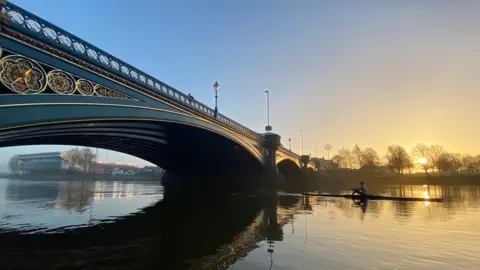 BBC
BBC"If you had to design a system of local government from scratch, you wouldn't do it the way we have it now."
That's what someone said to me the last time plans were on the table for a massive shake-up of Nottinghamshire councils.
That was in 2018. Seven years later, nothing has changed.
The county is still made up of different types of local authorities, in charge of different services, run in different ways.
And although there are different opinions on exactly what should shift, it does seem that change is now on the way.
In December, the government published plans to merge areas where there are currently two tiers of local authority - like Nottinghamshire.
The English Devolution White Paper also opened the door to boundaries being completely redrawn, and made clear that ministers favour single-tier, or unitary, structures.
On Wednesday, all nine council leaders across the city and county issued a joint statement saying they will "work together" to come up with proposals, and that all options are on the table.
So, what might those options be?
The status quo
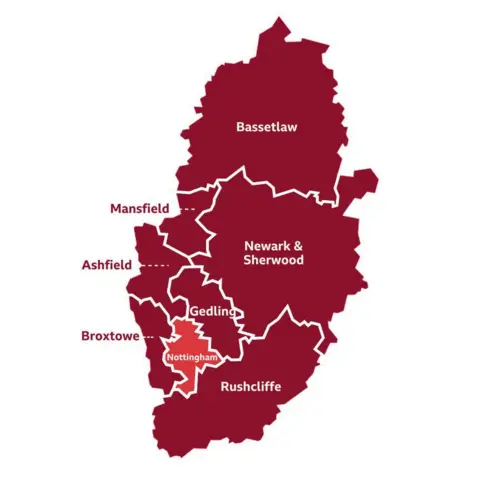
At the moment, there are two different systems depending on where you live.
The city of Nottingham itself is run by - you guessed it - Nottingham City Council.
It's a unitary authority, meaning it's in charge of all council services in the area it covers.
Elsewhere, however, there is a two-tiered system in a doughnut shape enveloping the city.
Nottinghamshire County Council is in charge of some services - like social care and road maintenance - while smaller district and borough councils take care of things like bin collections and leisure centres.
One of the arguments against this system is that it's just a bit messy and there's too much bureaucracy.
There are nine councils in total - not including town and parish councils - each with a chief executive and a headquarters.
It's also particularly problematic for the city council, because it has a small boundary, mostly covering low-income areas, with 80% of properties in council tax bands A or B.
Meanwhile, much of the city's more affluent suburbs aren't actually in the city's administrative area.
People living in those suburbs might go into the city and use city services, but they don't contribute to the city pot through council tax.
At this point, it seems like this system's days are numbered.
A unitary Nottinghamshire council
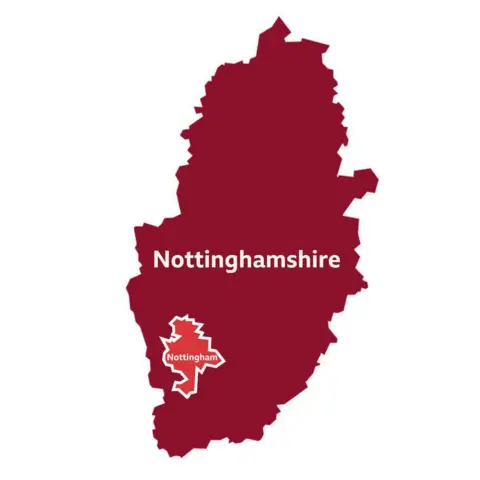
This would keep the current boundary between the city and the county in place, but would do away with the two-tiered system in the latter, turning Nottinghamshire into a unitary authority.
If you have a sense of déjà vu, that's because plans to do exactly that were put forward in 2018 by then leader of Nottinghamshire County Council, Kay Cutts.
They were met with a backlash from some of the district and borough leaders, who argued it wouldn't save any money and that decisions for some areas would be made in a building many miles away.
Ultimately, it all fell apart and Cutts stepped down as leader in 2021.
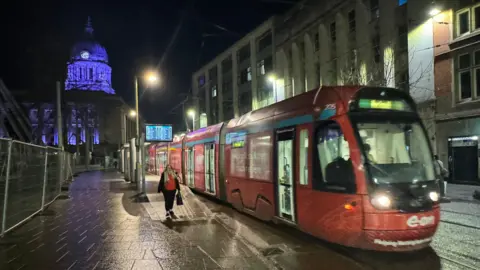
Some of those who opposed reorganisation then, seem opposed to it still.
Speaking on the day the new plans were published in December, Broxtowe Borough Council leader Milan Radulovic called them "anti-democratic".
"Some Whitehall mandarin will say bigger is better, but it isn't," he said.
"The reality is it will place a huge shackle on local people and local decision-making and centralise it into an area in which you've no say over your future."
The difference now is that reorganisation is being pushed by central government, so this scenario is back on the table.
The government, however, says new councils should have a population of 500,000 or more.
Nottingham city currently has a population of about 320,000, but ministers say there may be exceptions, and decisions will be made on a case-by-case basis.
A bigger city
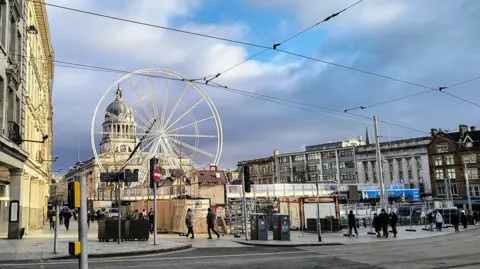 Steve Plew
Steve PlewOne idea is to expand the city to take in some of the adjoining suburbs, with unitary authorities on either side of the border.
It's not at all clear where exactly that boundary would be - so take the map below with a big pinch of salt - but it could see places like Beeston, West Bridgford and Arnold absorbed by the city.
The government has indicated it is open to the idea of redrawing boundaries in this way.
The White Paper says the government will look at reorganising existing unitary authorities "where there is evidence of failure or where their size or boundaries may be hindering their ability to deliver sustainable and high-quality services".
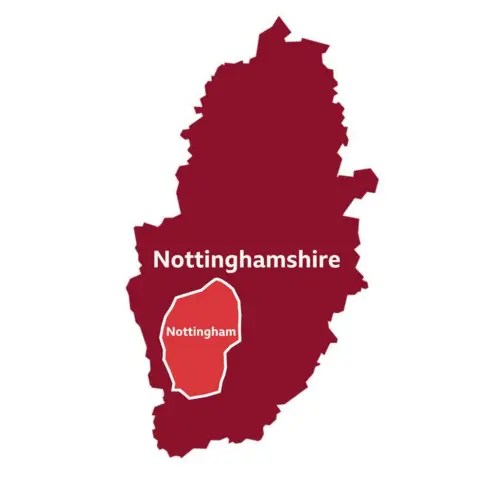
Nottingham City Council ticks both of those boxes.
While this scenario may go some way to solving that council tax issue, it could be a tough sell to people in the areas set to be absorbed by a city with such well-documented financial problems.
The Labour leader of Gedling Borough Council, John Clarke, made his position clear in a recent interview.
"The people of Gedling do not want to join the city. They don't mind some sort of change but they do not want to be dragged into the city because there's a lot of problems down there," he said.
Likewise, county council leader Sam Smith has previously indicated he would welcome a unitary status for Nottinghamshire, but said he would "do all I can to preserve the existing boundaries of this great county".
A county-wide 'super council'
 Nottinghamshire County Council
Nottinghamshire County CouncilAt a glance, this looks like the most straightforward option - one huge unitary authority covering the entire city and county.
The argument against it, however, is that it is simply too vast.
It would mean a population of well over one million people, covered by a single council.
I'm told this is a red line for some council leaders, so it appears to be an unlikely outcome.
A north and south Nottinghamshire
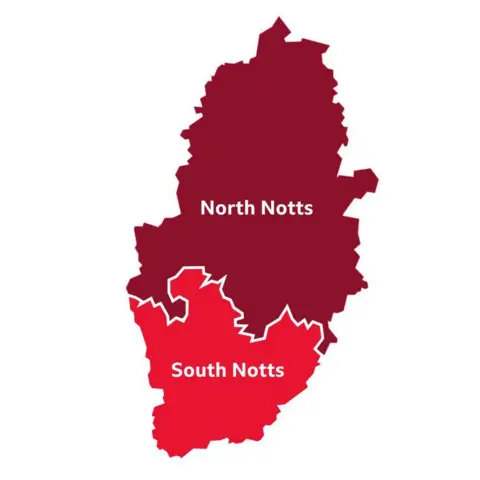
This would effectively involve splitting the county in two.
Bassetlaw, Mansfield, Ashfield, and Newark & Sherwood could combine to create a unitary authority in the north.
Nottingham city, Broxtowe, Gedling and Rushcliffe could then merge in the south.
The arguments for and against, however, are much the same as some of the options above.
It would help the city with its council tax base, but once again there would likely be resistance from neighbouring boroughs.
Another concern with this plan is that the two authorities would be financially imbalanced.
"The northern council would just go bust," one council leader told me.
Something else?
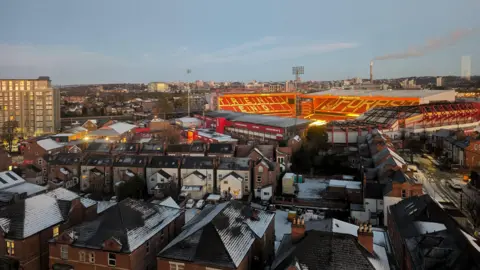 Angela Lady Bay
Angela Lady BayThe nine main council leaders have agreed to meet regularly, so any number of other ideas could yet emerge.
I've also heard an east-west split mentioned, for example, but it's unclear where that boundary would be.
As Gedling's John Clarke said: "There are all sorts of permutations."
"We could go with Rushcliffe or Broxtowe," he added.
"We may look at joining with Ashfield or Mansfield - or even further."
Expect more of this sort of talk in the coming weeks.
So what now?
It is early days, and it's important to note that all of the scenarios above are hypothetical rather than concrete proposals.
That said, things are moving fairly quickly.
While Nottinghamshire doesn't appear to be near the top of the government's priority list for reorganisation, there is an expectation for interim plans to be submitted by the end of March.
More detailed proposals are then due to be drawn up by the autumn, with the new structure implemented in 2027 or 2028.
The different council leaders seem to be working more harmoniously than the last time changes were on the table.
But how long will that last as they start to discuss proposals in earnest?
Follow BBC Nottingham on Facebook, on X, or on Instagram. Send your story ideas to [email protected] or via WhatsApp on 0808 100 2210.
